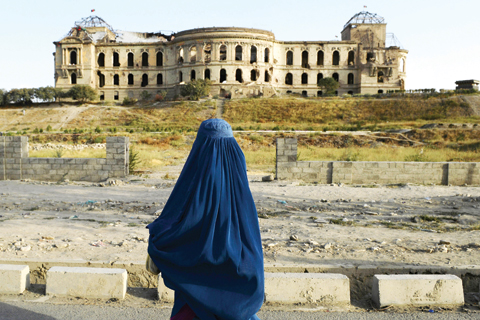 KABUL: This file photo taken on August 22, 2014 shows an Afghan burqa-clad woman in front of the ruined Darul Aman Palace, once the residence of former Afghan king Amanullah Khan between 1920-1929. — AFP
KABUL: This file photo taken on August 22, 2014 shows an Afghan burqa-clad woman in front of the ruined Darul Aman Palace, once the residence of former Afghan king Amanullah Khan between 1920-1929. — AFPKABUL: A string of coordinated Taleban attacks on police checkpoints in the increasingly volatile southern Afghan province of Helmand killed at least 12 policemen, an official said yesterday. Also, seven police officers were wounded in the attacks and seven others were missing, presumably abducted by the Taleban. The attacks, which took place in the province's Gereshk district, were launched Sunday night and lasted for many hours, said Hismatullah Daulatzai, head of police for the greater Helmand zone.
The 15-year insurgency in Afghanistan has intensified across the south as the Taleban concentrate their war on Helmand, Kandahar and Uruzgan provinces. Many of the attacks target police checkpoints, with Taleban fighters stealing weapons, ammunition and vehicles - and often abducting Afghan forces. On Saturday, Taleban fighters killed at least four policemen in Helmand's Nahri Sarraj district in similar attacks.
The fight in the southern, opium poppy-producing region is led by Mullah Yaqoub, the son of the one-eyed founder and late leaders of the Taleban, Mullah Mohammad Omar. Mullah Omar's successor, Mullah Akhtar Mansour, was killed in a US drone strike this month almost a year after officially taking over when the death of his predecessor was revealed. After Mansour's death, Mullah Haibatullah Akhundzada, a conservative cleric with no battlefield experience and a deputy to Mansour, was named to lead the group.
As the summer fighting season progresses, military officials are expecting the violence to escalate with Akhundzada's need to consolidate power. Yaqoub and the head of the brutal Haqqani network, Sirajuddin Haqqani, were named as deputies to Akhundzada. Rivalries have also become entrenched, with the main dissident group that broke away to protest Mansour's leadership - and which is now led by Mullah Mohammad Rasool - has vowed not to reconcile with the Taleban.
Restoration starts at palace
Afghan President Ashraf Ghani on Monday launched restoration work at Kabul's historic Darul Aman Palace, whose bombed out ruins have long symbolized the suffering caused by decades of conflict. The once-grand hilltop palace at the edge of Kabul was also the venue of Ghani's cabinet meeting on Monday, the first such official gathering there in nearly a century.
The building's lion-headed buttresses are broken, its colonnades pockmarked by bullets, the metal sheets of its roof crumpled. Up to $20 million will be spent on restoring the former glory of the palace, built by Afghan King Amanullah Khan in the 1920s, Ghani's office said, calling the project a symbol of national pride.
"Today we are returning to our past... to set the foundation for our future," Ghani said at the inauguration of the project. "We are determined to reconstruct the historical structure from the budget of the Afghan government." The palace fell victim to the carnage of the early 1990s as rival mujahideen groups fought for power following the fall of a Soviet-backed regime after Moscow withdrew its troops from Afghanistan.
Despite Ghani's rhetoric, some in Kabul were against the restoration, however-albeit for different reasons. "I think it is a waste of money," Daud Hotak, a Kabul shopkeeper, told AFP. "It comes at a time when the economy is in free fall and security is deteriorating. That money could have been spent to create jobs as thousands of people flee the country."
Omaid Sharifi, a civil society activist, also pleaded against the restoration, though from a different perspective. "President @ashrafghani keep #DarulamanPalace like this, let's remind our younger generation (of) the brutality of war," he said on Twitter. - AFP










